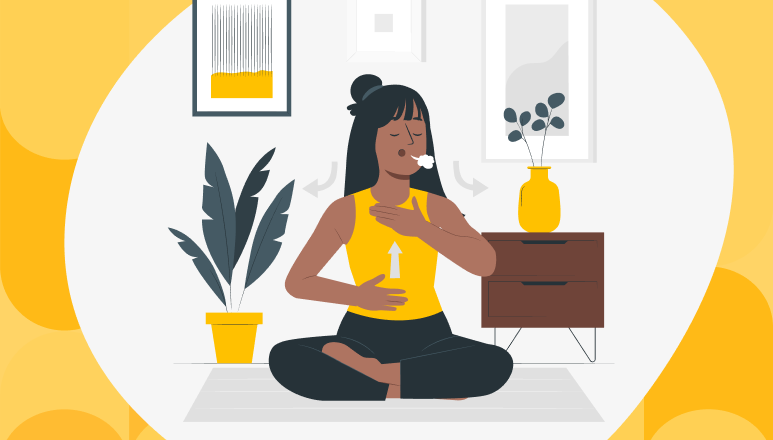The method involves a cycle of a 4-count inhale, a 4-count hold, a 4-count exhale, and another 4-count hold. The results are immediate, making it an easy and effective way to reduce stress and tension.
Check out our video below to see how you can incorporate box breathing into your routine for a calmer and more centered state:
How Can I Engage in Box Breathing?
Engaging in box breathing involves a cyclical sequence of the following steps:
– Inhaling for a count of 4
– Holding the breath for a count of 4 with the lungs filled
– Exhaling for a count of 4
– Holding the breath for a count of 4 with the lungs empty.
Some individuals may opt for a longer duration, either five or six counts, allowing you to customize the practice based on your preferences.
For how much time should I engage in box breathing?
The duration of box breathing is flexible, ranging from as short as one minute to 10 minutes or even longer, depending on the level of stress relief you seek. Alternatively, you can experiment with a specific number of cycles rather than a set timeframe, such as attempting ten cycles in one session. If uncertain, a recommendation is to aim for 5 minutes (approximately 20 cycles), as research indicates that just 5 minutes daily can effectively reduce stress and foster positive emotions.
When is the ideal time for practicing box breathing?
There are two opportune moments to engage in box breathing:
- Incorporate the technique into your daily routine for overall calmness. This involves making box breathing a regular part of your morning regimen. The concept is to cultivate a sense of calm in your body during non-stressful periods, thereby preventing anxiety and stress from arising later in the day.
- Implement the technique during moments of heightened tension. If you find yourself on edge or experiencing high anxiety, this is an ideal time to utilize box breathing to induce relaxation and rediscover your center.
The Step-By-Step Guide to Box Breathing
Now that you have a grasp of the fundamentals, let’s dissect a step-by-step guide to ensure you derive maximum benefit from this practice.
- Get into a comfortable position:
– Sit or lie down, or if needed, stand for box breathing.
– Ensure your spine is straight and relaxed, using a supportive chair or cushion if sitting, or lying down with a pillow under your head and bent knees.
– The more relaxed your body, the greater the benefits from the practice.
- Start the cycle:
– In a comfortable position, commence by:
– Inhaling through your nose for four counts (1–2–3–4).
– Holding the breath for four counts (1–2–3–4).
– Exhaling slowly through your mouth for four counts (1–2–3–4).
– Finally, hold again for four counts (1–2–3–4).
This completes one cycle of box breathing.
- Visualize while breathing:
– Enhance the effectiveness by visualizing during each stage:
– Inhale: Picture yourself filling with bright, positive energy.
– Hold: Envision the positive energy pulsating throughout your body.
– Exhale: Imagine releasing all tension from muscles and mind.
– Hold: Allow calmness to settle into every corner of your being.
Some find it helpful to imagine walking around a box while breathing:
– Walk up the left side of the box on the inhale.
– Cross the top on the hold.
– Walk down the right side on the exhale.
– Cross the bottom on the hold.
Repeat these cycles until you feel relaxed and relieved from stress and anxiety. It’s crucial to note that this exercise should involve no strain; aim for gentle yet intentional breaths at a natural rate for your body type and lifestyle.
If mastering stress-relieving breathing techniques aligns with your goals, exploring science-backed techniques for overall life improvement might interest you. Check out this free course to delve into those possibilities: MASTER YOUR SKILLS
6 Situations Ideal for Box Breathing
Box breathing proves to be a remarkably versatile technique, applicable in diverse situations to diminish stress and anxiety, enhance focus, and induce relaxation. Here are some prevalent scenarios where box breathing can prove helpful:
Utilizing Box Breathing in Times of Overwhelm or Anxiety
When feelings of anxiety, overwhelm, or edginess arise, take a momentary break and engage in a few minutes of box breathing to swiftly regain composure. Box breathing can prove particularly beneficial when teetering on the brink of a panic attack, providing a means to step back from the edge.
The technique activates your vagus nerve 2 and parasympathetic nervous system, fostering a calming effect on your body. This enables you to regain emotional control, empowering you to more effectively navigate the challenges at hand. If you find yourself resonating with the distressed Squirtle below, a brief pause for a few minutes of box breathing can be immensely helpful!
Pairing breathing exercises with introspective activities can further enhance their effectiveness. If you’re interested in improving your relationship with your inner critic, here are a few ideas to consider.
Incorporating Box Breathing to Navigate Chronic Stress and Burnout
If you find yourself amidst months of accumulating stress, where life seems akin to a steaming pile of burnout, introducing box breathing into your routine could serve as a valuable means of restoration.
Box breathing proves effective in relaxing both the body and mind. As we regulate our breathing, it diminishes bodily tension and alleviates stress. The beauty of this technique lies in its minimal time commitment. In a research study 1, 90% of participants practicing box breathing for just 5 minutes daily over a month reported experiencing heightened positive feelings along with reduced stress and anxiety.
Incorporating a few minutes of this practice into your daily routine has the potential to gradually alleviate the burnout you may be experiencing.
Leveraging Box Breathing to Achieve Calmness Before Significant Events
Box breathing has gained popularity 3 as a tool for individuals facing high-stakes situations, including various professionals in demanding occupations. Some of the fields that train their personnel in box breathing include:
– Navy SEALs
– Military
– First responders
– SWAT teams
– Firefighters
– Police officers
A former Navy Seal attests to the efficacy of box breathing, stating that it aided him and his comrades in avoiding panic, recognizing that succumbing to worry, anxiety, and stress can lead to detrimental outcomes.
Referred to as “combat tactical breathing” by the military and utilized by police forces and SWAT teams 4, box breathing serves as a method to induce calmness and enhance focus before entering tense and dangerous situations. While you may not regularly find yourself in scenarios like jumping into burning buildings or raiding enemy bunkers, everyday situations can still induce stress, worry, and even panic.
Consider dedicating 5 minutes to box breathing right before engaging in significant events such as giving a wedding speech, interviewing for a job, presenting at work, or meeting your Hinge date. This practice effectively lowers your heart rate and blood pressure while increasing oxygen flow throughout the body 5, fostering confidence and composure when the time comes to perform.
Incorporating Box Breathing for Enhanced Focus in Meditation
For avid meditators, maintaining focus is a key aspect of any meditation practice, regardless of its specific type. Whether engaged in a body scan or visualization, the ability to keep attention concentrated facilitates a deeper and more enriching meditation experience.
A clever approach to leverage box breathing is to use it as a warm-up for your meditation session. For instance, if you plan on a 20-minute guided meditation, dedicate the initial 5 minutes to box breathing. This not only calms your body and mind but also sets the stage for directing your attention more effectively throughout the remaining meditation time.
On the contrary, experimenting with box breathing after your meditation can further enhance the depth of your practice, providing a holistic and balanced approach to your mindfulness routine.
Reclaiming Focus with Box Breathing Amid Workplace Distractions
Imagine this scenario: you have a substantial work project ahead, allocating an hour for concentrated effort. Within this task, you need to locate a specific YouTube video. However, the YouTube rabbit hole beckons, tempting you with an intriguing video that suddenly feels indispensable, promising to enhance your work project. Thirty minutes later, your timer interrupts your unintended detour. Sound familiar?
We’ve all found ourselves in the realm of endless distractions while attempting to work, particularly in the digital age. On days when focus seems elusive, especially during a crucial work project, a block of box breathing might be the remedy to soothe a distracted mind and regain your concentration.
Studies 6 have indicated that the most productive workers often engage in undistracted, deep focus for 52 minutes, followed by a complete 17-minute break from work. If you incorporate breaks into your workday, consider integrating box breathing during one of these intervals. Gauge whether it aids in relaxation and helps you rebuild focus.
Should your mind feel cluttered and your focus elusive, pairing box breathing with other activities from a curated list might offer a comprehensive approach to clearing mental space and enhancing concentration.
Box Breathing: Your Ticket to a Tranquil Sleep
Say goodbye to counting sheep! If a racing mind is keeping you from falling asleep, consider incorporating box breathing into your bedtime routine 7. Its calming effects work wonders in relaxing both the mind and body, providing an effective alternative to the traditional sleep aid.
Sleep medicine physician Dr. Funke Afolabi-Brown recognizes box breathing as a valuable strategy for inducing sleep. By directing your focus to intentional breathing, it effectively distracts the mind from intrusive thoughts, creating a serene pathway to a restful night’s sleep. Sweet dreams!
Unlocking the Health Benefits of Box Breathing
Box breathing, a form of diaphragmatic breathing also known as “belly breathing” or “abdominal breathing,” goes beyond just calming the breath—it creates a profound sense of calm by engaging the vagus nerve and diminishing the activity of the sympathetic nervous system responsible for our “fight or flight” response.
Here’s a glimpse into the core health advantages of integrating box breathing into your routine:
– Stress Hormone Regulation: Box breathing triggers the body’s relaxation response, reducing cortisol 8 (the stress hormone) levels while elevating serotonin, the “happy hormone.”
– Activation of the Parasympathetic Nervous System: This technique activates the parasympathetic nervous system 2, offering a powerful tool to calm anxiety and foster a sense of tranquility.
– Enhanced Oxygen Flow: Box breathing promotes increased oxygen 9 flow throughout the body, aiding clearer thinking and helping to maintain focus on the present moment rather than succumbing to future worries.
– Cardiovascular Benefits: Lowering heart rate, reducing blood pressure, and decreasing physiological arousal are additional perks, making box breathing a valuable ally in calming nerves.
– Heart Rate Variability Improvement: Box breathing contributes to increased heart rate variability, a marker associated with enhanced mental health outcomes, including improved emotional regulation and decreased symptoms of depression.
Embrace the holistic benefits of box breathing to not only nurture your respiratory well-being but also to create a foundation for a calmer, more balanced life.
Exploring Additional Resources and Tools for Box Breathing
Whether you prefer the solitude of personal practice or thrive on the structure and guidance provided by apps or videos, there are numerous resources available to enhance your box breathing experience. If you’re interested in trying box breathing with the assistance of online tools, here are a few options to explore
Harnessing the Power of a GIF for Breath Timing
While GIFs are often synonymous with adorable animals and amusing celebrity moments, here’s a unique twist: you can employ a simple GIF to enhance your wellness, specifically aiding in breath timing. Check out this GIF designed to assist you in timing your breathing:
Feel the rhythm of the GIF aligning with your breath, providing a visual cue for each phase of your box breathing cycle. Sometimes, a touch of visual engagement can amplify the effectiveness of your wellness practices. Give it a try and let the GIF guide you towards a more centered and mindful breathing experience.
The Ultimate Box Breathing App: Unbeatable Mind
If you’re in search of an exceptional app to guide you through your box breathing sessions, look no further than the Unbeatable Mind app. Developed by Mark Divine, a former Navy SEAL Commander turned bestselling author and podcast host, this app is a testament to the efficacy of box breathing, a practice championed by Divine based on its utility in the Navy.
For a nominal fee of $4.99, the Unbeatable Mind app offers a comprehensive platform to support your box breathing journey. Mark Divine’s firsthand experience and commitment to the practice make this app a standout choice for those seeking structured guidance and a touch of SEAL-inspired resilience.
Here’s the link for the iOS version.
And here’s the link for Android.
Embrace Serenity with Guided Box Breathing Audio
For a seamless and immersive box breathing experience, consider this audio recording designed to guide you through the rhythmic cadence of inhaling, exhaling, and holding. The session spans approximately 8 minutes of focused breathing, followed by a tranquil meditation outro lasting about 1 minute.
Frequently Asked Questions About Box Breathing
Is box breathing beneficial for managing anxiety?
Box breathing proves to be an effective technique for handling anxiety. When you engage in the deliberate and deep inhalation and exhalation, it soothes the body’s nervous system, empowering you to regain command over your emotions.
Does the practice of box breathing yield results?
The efficacy of box breathing lies in its ability to diminish stress and anxiety by pacifying the body’s nervous system. It has been successfully employed by diverse professionals, including Navy SEALs and SWAT teams, to navigate high-stress situations.
What advantages can be derived from box breathing?
The merits of box breathing encompass the initiation of the body’s relaxation response, reduction of cortisol levels, activation of the parasympathetic nervous system to quell anxiety, and augmentation of oxygen flow throughout the body. Additionally, it has the potential to decrease heart rate, lower blood pressure, and contribute to enhanced mental well-being.
Why is box breathing effective?
Box breathing functions effectively because the deliberate practice of prolonged, unhurried breathing activates the body’s relaxation response, leading to a reduction in cortisol levels. It also stimulates the parasympathetic nervous system, fostering a state of calmness to counter anxiety. Moreover, this deliberate diaphragmatic breathing enhances the flow of oxygen, facilitating mental clarity and focus.
Key Insights on Box Breathing
Box breathing has gained widespread recognition, fueled in part by endorsements from various Navy SEALs. To practice this technique:
- Inhale for 4 seconds
- Hold your breath for 4 seconds
- Exhale for 4 seconds
- Hold your breath for 4 seconds
This sequence constitutes one cycle. You can choose to complete a specific number of cycles (e.g., 5, 10, or 20) or set a timer for a duration ranging from 1 to 10 minutes or more.
Ideal moments to incorporate box breathing include:
– When feeling overwhelmed or on the brink of panic, using box breathing can swiftly restore calm.
– Managing chronic stress by integrating box breathing into your daily routine.
– Easing nerves before significant events by practicing a few minutes of box breathing.
– Commencing a meditation session, enhancing focus and calm for the entire practice.
– Regaining focus if distracted at work, whether during a break or within work intervals.
– Facilitating sleep by practicing box breathing while in bed to relax the body and prepare the mind.
Wishing you success on your journey of mindful breathing! If you’re eager to explore additional breathing techniques, here’s a list of 9 methods that prove particularly helpful before significant events, such as giving a speech.
- https://www.cell.com/cell-reports-medicine/fulltext/S2666-3791(22)00474-8?_returnURL=https%3A%2F%2Flinkinghub.elsevier.com%2Fretrieve%2Fpii%2FS2666379122004748%3Fshowall%3Dtrue
- https://www.ncbi.nlm.nih.gov/pmc/articles/PMC6137615/
- https://www.med.navy.mil/Portals/62/Documents/NMFA/NMCPHC/root/Documents/health-promotion-wellness/psychological-emotional-wellbeing/Combat-Tactical-Breathing.pdf
- https://www.policemag.com/training/article/15346596/box-breathing
- https://link.springer.com/article/10.1007/s10484-020-09485-w
- https://desktime.com/blog/17-52-ratio-most-productive-people
- https://www.restfulsleepmd.com/blog/addressing-mind-racing-at-bedtime
- https://www.ncbi.nlm.nih.gov/books/NBK513238/
- https://www.ncbi.nlm.nih.gov/pmc/articles/PMC5455070/



